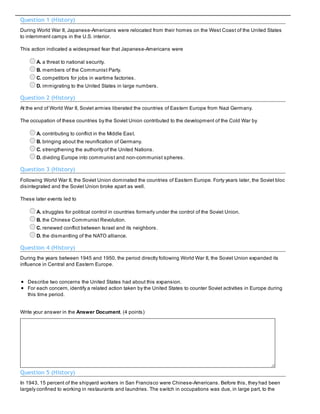
Cold war questions
- 1. Question 1 (History) During World War II, Japanese-Americans were relocated from their homes on the West Coast of the United States to internment camps in the U.S. interior. This action indicated a widespread fear that Japanese-Americans were A. a threat to national security. B. members of the Communist Party. C. competitors for jobs in wartime factories. D. immigrating to the United States in large numbers. Question 2 (History) At the end of World War II, Soviet armies liberated the countries of Eastern Europe from Nazi Germany. The occupation of these countries by the Soviet Union contributed to the development of the Cold War by A. contributing to conflict in the Middle East. B. bringing about the reunification of Germany. C. strengthening the authority of the United Nations. D. dividing Europe into communist and non-communist spheres. Question 3 (History) Following World War II, the Soviet Union dominated the countries of Eastern Europe. Forty years later, the Soviet bloc disintegrated and the Soviet Union broke apart as well. These later events led to A. struggles for political control in countries formerly under the control of the Soviet Union. B. the Chinese Communist Revolution. C. renewed conflict between Israel and its neighbors. D. the dismantling of the NATO alliance. Question 4 (History) During the years between 1945 and 1950, the period directly following World War II, the Soviet Union expanded its influence in Central and Eastern Europe. Describe two concerns the United States had about this expansion. For each concern, identify a related action taken by the United States to counter Soviet activities in Europe during this time period. Write your answer in the Answer Document. (4 points) Question 5 (History) In 1943, 15 percent of the shipyard workers in San Francisco were Chinese-Americans. Before this, they had been largely confined to working in restaurants and laundries. The switch in occupations was due, in large part, to the
- 2. A. shipbuilding skills of Chinese-Americans. B. increased availability of higher education for immigrants. C. increased labor union restrictions against Chinese-American workers. D. massive need for workers to build ships during World War II. Question 6 (History) Britain and France suffered heavy casualties during World War I. Because of this, when faced with Axis expansion before World War II, these countries were A. unwilling to take actions that might start another war. B. prepared to use military intervention wherever necessary. C. dependent on the United States to intervene in an international crisis. D. reluctant to call upon the League of Nations to settle disputes. Question 7 (History) The use of atomic weapons at the end of World War II fostered fears about their potential use during the Cold War years. These fears were critical in determining the U.S. response to A. the Marshall Plan. B. the Berlin Blockade. C. the Cuban Missile Crisis. D. the independence movement in India. Question 8 (History) In the United Nations Charter, member nations pledge to “unite our strength to maintain international peace and security.” Since ratification of its charter following World War II, the primary goal of the United Nations has been to A. restore world trade disrupted by World War II. B. encourage industrial growth begun during World War II. C. establish policies to help nations pay World War II debts. D. intervene in world conflicts to prevent another war such as World War II.